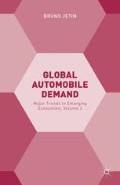Abstract
Historical patterns in car ownership in the world indicate that growing wealth is a powerful determinant of the demand. Turkey, with its young and large population, has one of the fastest growing economies in the world in 2010, which attracts the attention of global players because of its unsaturated passenger car market. Even though car ownership has been growing faster than income, one could expect a higher demand for cars given the income level reached by Turkey.
Access this chapter
Tax calculation will be finalised at checkout
Purchases are for personal use only
Preview
Unable to display preview. Download preview PDF.
Reference
ACEA (European Automobile Manufacturers Association) (2010) The Automobile Industry Pocket Guide. Brussels, ACEA Communications Department.
— (2011) The Automobile Industry Pocket Guide. Brussels, ACEA Communications Department.
Alper, C. E. & A. Mumcu (2007) “Interaction between price, quality and country of origin when estimating automobile demand: the case of Turkey”, Applied Economics, 39(14), pp. 1789–1796.
Chamon, M., P. Mauro & Y. Okawa (2008) “Mass car ownership in the emerging market giants”, Economic Policy, 23(54), pp. 243–296.
Cruz, M. J. V. & C. F. C. Rolim (2010) “The Brazilian automotive industry in the BRICs context: the case of the Metropolitan Region of Curitiba”, Cambridge Journal of Regions, Economy and Society, 3(3), pp. 319–334.
Dargay, J. & M. Sommer (2007) “Vehicle ownership and income growth, worldwide: 1960–2030”, Energy Journal, 28(4), pp. 143–170.
De Negri, J. A. (1998) Elasticidade-Renda e Elasticidade-Precxo da Demanda de Autonomó veis no Brasil. Brasilia, Brazil: Texto de Discussão. IPEA.
Duruiz, L. (2004) “Challenges for the Turkish Car Industry on Its Way to Integration with the European Union”, in Lung Y., Carrillo, J. & van Tulder, R. (eds), Cars, Carriers of Regionalism. Basingtoke, UK: Palgrave Macmillan, pp. 91–103.
— (2011) “Turkish automobile industry: an industrial base or an attractive market for EU?” Nineteenth International Colloquium. Paris: GERPISA.
EIU Economist Intelligence Unit (July 2011) Automotive Industry Report: Turkey. (http://www.eiu.com/industry/automotive/europe/turkey).
Erdem, C., I. Senturk & T. Simsek (2010) “Identifying the factors affecting the willingness to pay for fuel-efficient vehicles in Turkey: a case of hybrids”. Energy Policy, 38(6), pp. 3038–3043.
Eskeland, Gunnar S. & Feyzioğlu, N. Tarhan (1997) “Is demand for polluting goods manageable? An econometric study of car ownership and use in Mexico”, Journal of Development Economics, 53(2), pp. 423–445.
Hoeller, P., I. Joumard, M. Pisu & D. Bloch (2012) “Less income inequality and more growth — are they compatible? Part 1: mapping income inequality across the OECD”, OECD Economics Department Working Papers, No. 924. OECD Publishing.
IEA (2009) Energy Policies of IEA Countries, TURKEY 2009 Review. https://www.iea.org/publications/freepublications/…/turkey2009.pdf.
— (2010) Transport Energy Efficiency, Information Paper. Efficiency Series. https://www.iea.org/publications/…/transport_energy_efficiencypdf.
ISO İstanbul Sanayi Odası, (October 2010). 10 Year Trends for Large 500 Industry Firms (1999–2008). (http://www.iso.org.tr/yayinlarimiz/detay?categoryid=QpBzIHB6/3M=&page=3).
Johansson, O. & L. Schipper (1997) “Measuring the long-run fuel demand of cars. Separate estimations of vehicle stock, mean fuel intensity, and mean annual driving distance”, Journal of Transport Economics and Policy, 31(3), pp. 277–292.
LMC automotive (2010) Emerging markets forecasts (http://www.lmc-auto.com/services/emerging-market-reports/automotive-market-forecast).
Mikler, J. (2010) “Apocalypse now or business as usual/ reducing the carbon emission of the global car industry”, Cambridge Journal of Regions, Economy and Society, 3(3), pp. 406–426.
Ministry of Industry and Trade Turkey (2010) 2010 The Automotive Industry Report. Ankara.
OECD (2011) Forum on Tackling Inequality. Paris.
PETDER (Petroleum Industry Association) (2011) Sector Report. Istanbul, 4–6.
PwC (2011) Autofacts. January.
Rothschild, E. (2009) “Can we transform the auto-industrial society?” The New York Review of Books, 56(3).
SEDEFED (Federasyonu) (2010) Automotive Sector Competitiveness Report. Istanbul: Sabanci University, 34.
Storchmann, K. (2005) “Long-run gasoline demand for passenger cars: the role of income distribution”, Energy Economics, 27(1), pp. 25–58.
TUSİAD-Sabancı Universitesi Rekabet Forumu (REF) ve Sektorel Dernekler.
United Nations (2009) Main Transport Indicators. Geneva: United Nations Economic Commission for Europe Transport Division.
Urry, J. (1999) Auto Mobility, Car Culture and Weightless Travel. A discussion paper. Lancaster: Department of Sociology, Lancaster University.
Wheaton, W. C. (1982) “The long-run structure of transportation and gasoline demand”, Bell Journal of Economics, 13(2), pp. 439–454.
Whitmarsh, L. & J. Köhler (2010) “Climate change and cars in the EU: the roles of auto firms, consumers, and policy in responding to global environmental change”, Cambridge Journal of Regions Economy and Society, 3(3), pp. 427–441.
Whitmarsh, L., S. O’Neill, G. Seyfang & I. Lorenzoni (2009) “Carbon capability: what does it mean, how prevalent is it, and how can we promote it?” Tyndall Working Paper, No. 132.
Editor information
Editors and Affiliations
Copyright information
© 2015 Lale Duruiz and Orhan Erdem
About this chapter
Cite this chapter
Duruiz, L., Erdem, O. (2015). An Unsaturated Passenger Car Market in an Emerging Economy: The Case of Turkey. In: Jetin, B. (eds) Global Automobile Demand. Palgrave Macmillan, London. https://doi.org/10.1057/9781137516176_3
Download citation
DOI: https://doi.org/10.1057/9781137516176_3
Publisher Name: Palgrave Macmillan, London
Print ISBN: 978-1-349-70352-4
Online ISBN: 978-1-137-51617-6
eBook Packages: Palgrave Business & Management CollectionBusiness and Management (R0)

